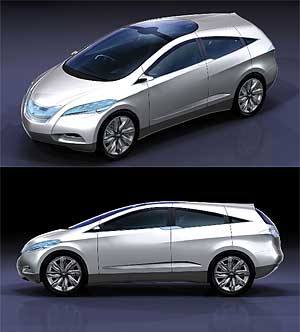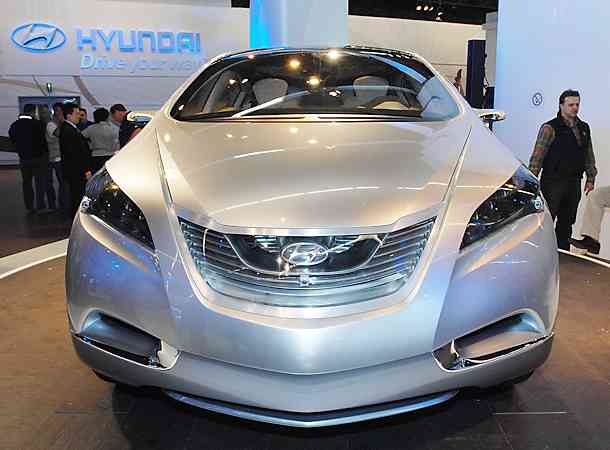Hyundai I-Blue
The Hyundai I-Blue goes green and has other carmakers seeing red at the 2007 Frankfurt International Motor Show in Germany.
|
The Hyundai I-Blue is based upon the newly developed D segment 2+2 crossover utility vehicle (CUV) body developed from the ground up in Chiba, Japan at the Hyundai Design and Technical Center. |
 Hyundai I-Blue |
The Hyundai I-Blue is a step up from the Tucson FCEV (built on an SUV platform), which was introduced in 2004 using the company’s second-generation fuel cell. The Hyundai I-Blue uses a third-generation fuel cell (100 kw) that has been repositioned from underneath the front hood (as with the Tucson FCEV) to sandwiched inside the floorboard.
This new positioning of the fuel cell gives the vehicle a better weight distribution and better ability to cool itself using outside air from the front grille. The third-generation fuel cell was developed in Mabuk, Korea.at the Eco-Technology Research Institute.
The Hyundai I-Blue is also capable of accelerating to 100 mph and has a range of 360 miles, giving it one of the farthest ranges of any other hydrogen-powered vehicle to date. The Hyundai I-Blue is fueled by compressed hydrogen gas stored at 10,000 psi in a 115-liter tank.
According to President of Research and Development, Dr. Hyun-Soon Lee, “Our engineering team has successfully designed a more compact fuel cell vehicle, while still realizing the safety, comfort, convenience and driving range of a traditional internal combustion engine vehicle.”

The Hyundai I-Blue is a four-seat vehicle and one of its most striking features are the space age bucket seats, front and rear in the fuel cell crossover. The cockpit design is sure to gain many fans as the vehicle was designed for comfort along with its zero emissions capabilities.
Other high-tech features of the Hyundai I-Blue include the aircraft steering wheel with touch-scroll pads for audio-video control, 3-D vision HUD (heads up display) and a full surround camera system projecting the outside environment at all times.
Hyundai says the I-Blue was designed on the concept of the Yin and Yang, merging opposite forces into one vehicle. The company has said that circle gets the square in this vehicle as the body was created by combining the two shapes and coming up with something similar to a rhombus.
Though the Hyundai I-Blue may be a rhombus, it is no bus, but rather a sophisticated glimpse at the future of what many other FCEV’s may one day look like. The Hyundai I-Blue is a green, mean environmental machine with long-range capabilities and a snazzy interior that will leave many other hydrogen carmakers seeing red for some time to come.